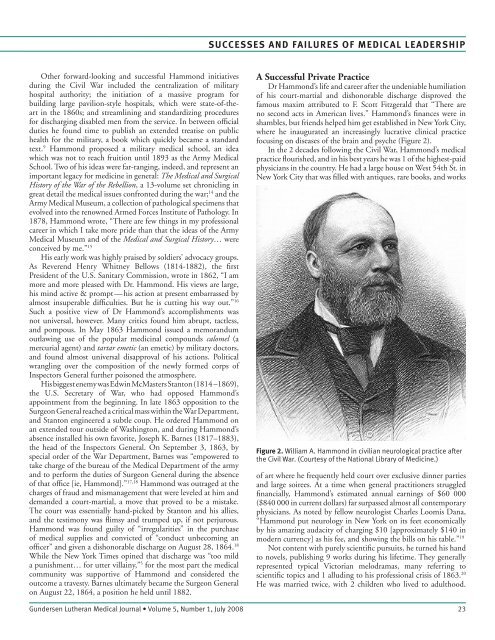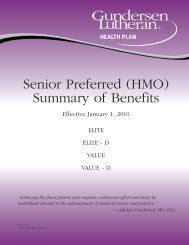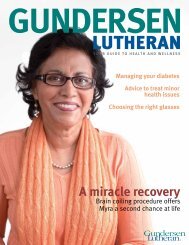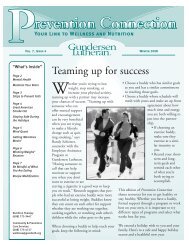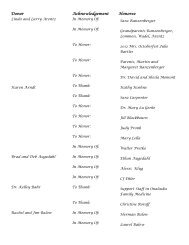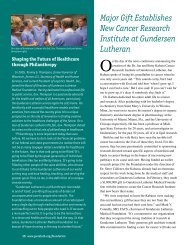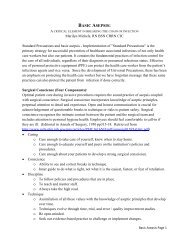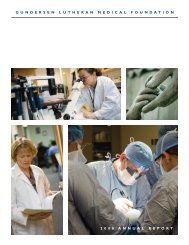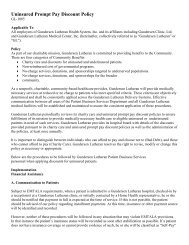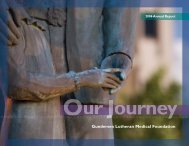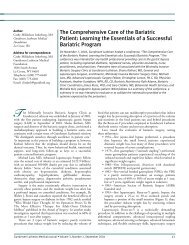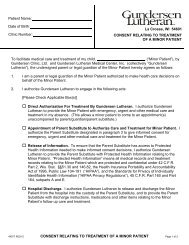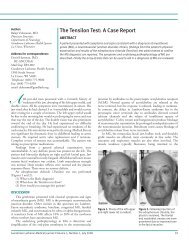ndersen er an - Gundersen Health System
ndersen er an - Gundersen Health System
ndersen er an - Gundersen Health System
You also want an ePaper? Increase the reach of your titles
YUMPU automatically turns print PDFs into web optimized ePapers that Google loves.
successes <strong>an</strong>d failures of medical lead<strong>er</strong>ship<br />
Oth<strong>er</strong> forward-looking <strong>an</strong>d successful Hammond initiatives<br />
during the Civil War included the centralization of military<br />
hospital authority; the initiation of a massive program for<br />
building large pavilion-style hospitals, which w<strong>er</strong>e state-of-theart<br />
in the 1860s; <strong>an</strong>d streamlining <strong>an</strong>d st<strong>an</strong>dardizing procedures<br />
for discharging disabled men from the s<strong>er</strong>vice. In between official<br />
duties he found time to publish <strong>an</strong> extended treatise on public<br />
health for the military, a book which quickly became a st<strong>an</strong>dard<br />
text. 9 Hammond proposed a military medical school, <strong>an</strong> idea<br />
which was not to reach fruition until 1893 as the Army Medical<br />
School. Two of his ideas w<strong>er</strong>e far-r<strong>an</strong>ging, indeed, <strong>an</strong>d represent <strong>an</strong><br />
import<strong>an</strong>t legacy for medicine in gen<strong>er</strong>al: The Medical <strong>an</strong>d Surgical<br />
History of the War of the Rebellion, a 13-volume set chronicling in<br />
great detail the medical issues confronted during the war; 14 <strong>an</strong>d the<br />
Army Medical Museum, a collection of pathological specimens that<br />
evolved into the renowned Armed Forces Institute of Pathology. In<br />
1878, Hammond wrote, “Th<strong>er</strong>e are few things in my professional<br />
care<strong>er</strong> in which I take more pride th<strong>an</strong> that the ideas of the Army<br />
Medical Museum <strong>an</strong>d of the Medical <strong>an</strong>d Surgical History… w<strong>er</strong>e<br />
conceived by me.” 15<br />
His early work was highly praised by soldi<strong>er</strong>s’ advocacy groups.<br />
As Rev<strong>er</strong>end Henry Whitney Bellows (1814-1882), the first<br />
President of the U.S. S<strong>an</strong>itary Commission, wrote in 1862, “I am<br />
more <strong>an</strong>d more pleased with Dr. Hammond. His views are large,<br />
his mind active & prompt — his action at present embarrassed by<br />
almost insup<strong>er</strong>able difficulties. But he is cutting his way out.” 16<br />
Such a positive view of Dr Hammond’s accomplishments was<br />
not univ<strong>er</strong>sal, howev<strong>er</strong>. M<strong>an</strong>y critics found him abrupt, tactless,<br />
<strong>an</strong>d pompous. In May 1863 Hammond issued a memor<strong>an</strong>dum<br />
outlawing use of the popular medicinal compounds calomel (a<br />
m<strong>er</strong>curial agent) <strong>an</strong>d tartar emetic (<strong>an</strong> emetic) by military doctors,<br />
<strong>an</strong>d found almost univ<strong>er</strong>sal disapproval of his actions. Political<br />
wr<strong>an</strong>gling ov<strong>er</strong> the composition of the newly formed corps of<br />
Inspectors Gen<strong>er</strong>al furth<strong>er</strong> poisoned the atmosph<strong>er</strong>e.<br />
His biggest enemy was Edwin McMast<strong>er</strong>s St<strong>an</strong>ton (1814 –1869),<br />
the U.S. Secretary of War, who had opposed Hammond’s<br />
appointment from the beginning. In late 1863 opposition to the<br />
Surgeon Gen<strong>er</strong>al reached a critical mass within the War Department,<br />
<strong>an</strong>d St<strong>an</strong>ton engine<strong>er</strong>ed a subtle coup. He ord<strong>er</strong>ed Hammond on<br />
<strong>an</strong> extended tour outside of Washington, <strong>an</strong>d during Hammond’s<br />
absence installed his own favorite, Joseph K. Barnes (1817–1883),<br />
the head of the Inspectors Gen<strong>er</strong>al. On Septemb<strong>er</strong> 3, 1863, by<br />
special ord<strong>er</strong> of the War Department, Barnes was “empow<strong>er</strong>ed to<br />
take charge of the bureau of the Medical Department of the army<br />
<strong>an</strong>d to p<strong>er</strong>form the duties of Surgeon Gen<strong>er</strong>al during the absence<br />
of that office [ie, Hammond].” 17,18 Hammond was outraged at the<br />
charges of fraud <strong>an</strong>d mism<strong>an</strong>agement that w<strong>er</strong>e leveled at him <strong>an</strong>d<br />
dem<strong>an</strong>ded a court-martial, a move that proved to be a mistake.<br />
The court was essentially h<strong>an</strong>d-picked by St<strong>an</strong>ton <strong>an</strong>d his allies,<br />
<strong>an</strong>d the testimony was flimsy <strong>an</strong>d trumped up, if not p<strong>er</strong>jurous.<br />
Hammond was found guilty of “irregularities” in the purchase<br />
of medical supplies <strong>an</strong>d convicted of “conduct unbecoming <strong>an</strong><br />
offic<strong>er</strong>” <strong>an</strong>d given a dishonorable discharge on August 28, 1864. 18<br />
While the New York Times opined that discharge was “too mild<br />
a punishment… for utt<strong>er</strong> villainy,” 5 for the most part the medical<br />
community was supportive of Hammond <strong>an</strong>d consid<strong>er</strong>ed the<br />
outcome a travesty. Barnes ultimately became the Surgeon Gen<strong>er</strong>al<br />
on August 22, 1864, a position he held until 1882.<br />
A Successful Private Practice<br />
Dr Hammond’s life <strong>an</strong>d care<strong>er</strong> aft<strong>er</strong> the undeniable humiliation<br />
of his court-martial <strong>an</strong>d dishonorable discharge disproved the<br />
famous maxim attributed to F. Scott Fitzg<strong>er</strong>ald that “Th<strong>er</strong>e are<br />
no second acts in Am<strong>er</strong>ic<strong>an</strong> lives.” Hammond’s fin<strong>an</strong>ces w<strong>er</strong>e in<br />
shambles, but friends helped him get established in New York City,<br />
wh<strong>er</strong>e he inaugurated <strong>an</strong> increasingly lucrative clinical practice<br />
focusing on diseases of the brain <strong>an</strong>d psyche (Figure 2).<br />
In the 2 decades following the Civil War, Hammond’s medical<br />
practice flourished, <strong>an</strong>d in his best years he was 1 of the highest-paid<br />
physici<strong>an</strong>s in the country. He had a large house on West 54th St. in<br />
New York City that was filled with <strong>an</strong>tiques, rare books, <strong>an</strong>d works<br />
Figure 2. William A. Hammond in civili<strong>an</strong> neurological practice aft<strong>er</strong><br />
the Civil War. (Courtesy of the National Library of Medicine.)<br />
of art wh<strong>er</strong>e he frequently held court ov<strong>er</strong> exclusive dinn<strong>er</strong> parties<br />
<strong>an</strong>d large soirees. At a time when gen<strong>er</strong>al practition<strong>er</strong>s struggled<br />
fin<strong>an</strong>cially, Hammond’s estimated <strong>an</strong>nual earnings of $60 000<br />
($840 000 in current dollars) far surpassed almost all contemporary<br />
physici<strong>an</strong>s. As noted by fellow neurologist Charles Loomis D<strong>an</strong>a,<br />
“Hammond put neurology in New York on its feet economically<br />
by his amazing audacity of charging $10 [approximately $140 in<br />
mod<strong>er</strong>n currency] as his fee, <strong>an</strong>d showing the bills on his table.” 19<br />
Not content with purely scientific pursuits, he turned his h<strong>an</strong>d<br />
to novels, publishing 9 works during his lifetime. They gen<strong>er</strong>ally<br />
represented typical Victori<strong>an</strong> melodramas, m<strong>an</strong>y ref<strong>er</strong>ring to<br />
scientific topics <strong>an</strong>d 1 alluding to his professional crisis of 1863. 20<br />
He was married twice, with 2 children who lived to adulthood.<br />
Gu<strong>nd<strong>er</strong>sen</strong> Luth<strong>er</strong><strong>an</strong> Medical Journal • Volume 5, Numb<strong>er</strong> 1, July 2008 23


